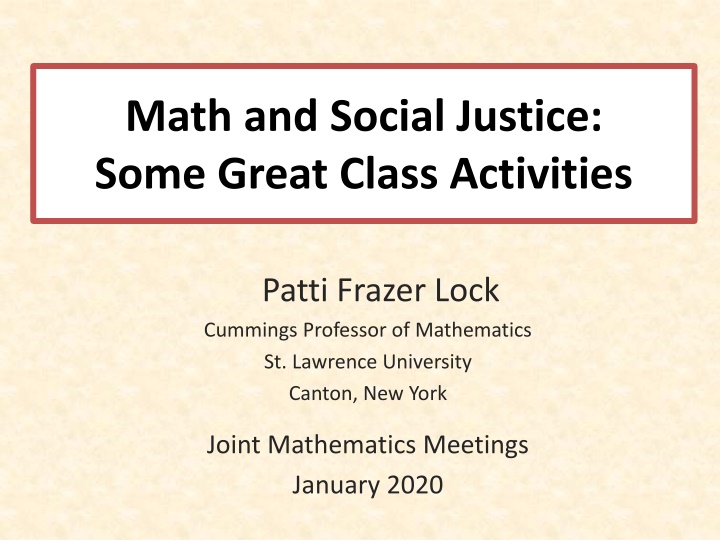Engaging Activities in Math for Social Justice Classes
Explore a variety of thought-provoking activities centered around math and social justice, ranging from voting theory to game theory. Dive into topics like apportionment, measures of inequality, statistics, and more, all designed to spark critical thinking and discussions in your math classes.
Download Presentation

Please find below an Image/Link to download the presentation.
The content on the website is provided AS IS for your information and personal use only. It may not be sold, licensed, or shared on other websites without obtaining consent from the author.If you encounter any issues during the download, it is possible that the publisher has removed the file from their server.
You are allowed to download the files provided on this website for personal or commercial use, subject to the condition that they are used lawfully. All files are the property of their respective owners.
The content on the website is provided AS IS for your information and personal use only. It may not be sold, licensed, or shared on other websites without obtaining consent from the author.
E N D
Presentation Transcript
Math and Social Justice: Some Great Class Activities Patti Frazer Lock Cummings Professor of Mathematics St. Lawrence University Canton, New York Joint Mathematics Meetings January 2020
Math and Social Justice: Senior Seminar Spring semester, 2019 Math and Social Justice: Sophomore Seminar To be taught: Spring Semester 2020 The specific activities for today: One Module: First Year Program Multiple times
Math and Social Justice: Senior Seminar First half: Topics in Math and Social Justice Second half: Student-driven projects
Topics 1. Voting Theory a) Voting Methods b) Voting Theory c) Weighted Voting Systems 2. Apportionment a) Fair Division Methods b) Apportionment Methods (esp. in Congress) c) Gerrymandering 3. Measures of Inequality a) Gini Index b) Compensation ratios 4. Cooperation/Competition/Prejudice a) Game Theory: Prisoner s Dilemma b) Effect of prejudice on group dynamics 5. Statistics and Social Justice a) Racism and soccer referees b) Racism and the courts c) Racism and police d) Elementary education in India e) Toxic waste sites and cancer f) Stats4Good, etc
Game Theory: Prisoner s Dilemma Two players: Each player must decide to Cooperate (be nice) Or Defect (not be nice!)
Game Theory: Prisoner s Dilemma Great 3-minute video: Goldenball: Split or Steal Both cooperate: Split big pot of money! One defects, one cooperates: Defector gets ALL the money! Both defect: No one gets any money.
GAME #1: Understand Prisoners Dilemma Two fingers = Cooperate One finger = Defect Rules: Both cooperate: Each gets 3 points. One of each: Defector gets 5 points, Cooperator gets 0. Both defect: Each loses a point. Pair up and play 10 rounds! Winner gets Reese s Peanut Butter Cups!
Game Theory: Iterated Prisoner s Dilemma Good strategy: Tit-for-Tat Start out cooperating. Then respond with whatever your opponent did on the last move.
Game #2: Play against many Two fingers = Cooperate One finger = Defect One round at a time. Play as many rounds as you can with as many different people as you can. Wander the room! We won t keep score but there are rules
The Players Angel: Always cooperate. Sociopath: Always defect. Benign Player: Tit for Tat . Start out cooperating with everyone. If someone defects against you, you will defect against them if you play against them again.
Describe the long term outcome if: The population is all angels. The population is all sociopaths. The population is all benign players. The population is half benign players and half angels. The population is all benign players except for one sociopath.
Game #3: One adjustment Two fingers = Cooperate One finger = Defect One round at a time. Play as many rounds as you can with as many different people as you can. Wander the room! We won t keep score but there are rules
The Players Angel: Always cooperate. Sociopath: Always defect. Benign Player: Tit for Tat . Start out cooperating with everyone. If someone defects against you, you will defect against them if you play against them again. Benign Bigot: Like Benign Player (Tit for Tat), but can t tell people of the opposite sex apart. OR: Can t tell people apart if they have a different gender orientation than you do. OR: Assign students to group A and group B using red/blue stickers, and tell them they can t tell people of the other group apart.
Describe the long-term outcome if: The population is all benign bigots. The population is half benign bigots and half angels. The population is all benign bigots except for one sociopath.
2000 people, in two groups A and B. One sociopath, 1999 benign bigots. What happens? Percent of group to group defections over time: A little malice goes a long way.
Note #1: Almost everyone in the population is a good person who really wants to cooperate with everyone. The people in each group have no animosity toward the other group. They just see them as the other group.
Note 2: There was just one sociopath in a population of 2000 people! Let s talk about the sociopath possibly just accidentally or inadvertently defected. maybe didn t even defect and someone just misunderstood.
A little malice goes a long way. One sociopath in a group in which everyone else wants to cooperate: Result is complete group to group defection.
What can we do about this? Option 1: Throw some angels into the mix. (Studied. Not very effective.) Option 2: Throw the sociopath in jail. (Already too late.) Option 3: ?????
1 sociopath. 1,999 benign others. What would the outcome be if the groups didn t stereotype? (A little malice would NOT go a long way.)
What can we do about this? Option 1: Throw some angels into the mix. (Studied. Not very effective.) Option 2: Throw the sociopath in jail. (Already too late.) Option 3: Teach people to not see others as the other . Very effective!!!
From A Note on Modeling Prejudice, by Alan Lockard and Ed Harcourt, 2009: The underlying problem is not one of malice, but of identification. Given that prejudice is an extremely effective, if not entirely accurate, means of economizing on information, our model provides an explanation for how a benign attitude toward others at the micro level can yield intergroup animus at the macro level.
Thanks for listening! plock@stlawu.edu www.lock5stat.com























